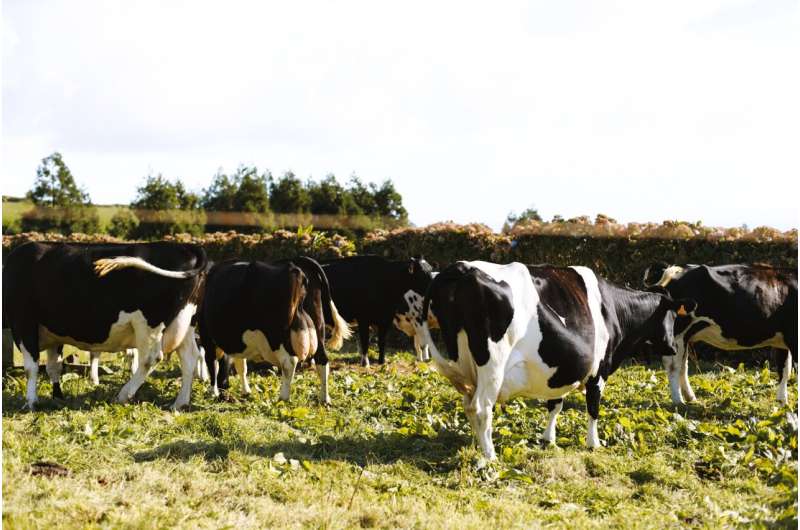This article has been reviewed according to Science X's editorial process and policies. Editors have highlighted the following attributes while ensuring the content's credibility:
fact-checked
trusted source
proofread
New study launches following the discovery of a second case of avian influenza spreading from cows to humans

Vaccination remains the most effective strategy for avian influenza prevention and control in humans, despite varying vaccine efficacy across strains.
That's according to the authors of a new review which delves into existing research into bird flu vaccines for humans.
Published in the journal Human Vaccines & Immunotherapeutics, the results of the paper are particularly timely following news on 22 May that the bird flu strain H5N1 had once again, for a second time, jumped from cattle in America to a human—prompting fears of subsequent human-to-human infection, with possible critical consequences.
Instances of the avian influenza were first recognized in US cattle in March. Since then, this strain has mainly spread from cow-to-cow and scientists have discovered very high levels of virus in raw milk (pasteurized milk is safe, having shown viral RNA but not infectious virus). To date, two people, however, are known to have contracted the bird flu virus. Both patients—US farmers—only reported eye symptoms and with treatment they made a full recovery.
Following tests on the first human instance, it was seen that the strain had mutated to be better adapted to mammalian cells, but as long as that human didn't pass it onto another person it likely stopped the spread at that point.
With the second case, the CDC has released a statement to say it has been monitoring influenza surveillance systems intently, especially in impacted states. "There has been no sign of unusual influenza activity in people, including in syndromic surveillance," they report.
The concern now, though, is that if H5N1 continues to be given the environment in which to mutate (such as in close quarter cattle farms)—and this continues long enough—it has the potential to find a combination that will easily spread to humans.
The results of this new research, carried out by a team at the University of Georgia, U.S., suggests vaccines still remain our "primary defense" against potential spread of avian influenzas such as the H5N1 and others assessed.
"The H5N1, H7N9, and H9N2 subtypes of avian influenza virus pose a dual threat, not only causing significant economic losses to the global poultry industry but also presenting a pressing public health concern due to documented spillover events and human cases," explains lead author Flavio Cargnin Faccin, who alongside his mentor Dr. Daniel Perez of the University of Georgia, U.S., analyzed the current landscape of research into human vaccines for these bird flus.
"This deep delve into the landscape of avian influenza vaccines for humans shows vaccination remains the primary defense against the spread of these viruses."
The team examined studies of vaccines tested in mice, ferrets, non-human primates, and clinical trials of bird flu vaccines in humans, and assessed both established platforms and promising new directions.
The review carried out suggests inactivated vaccines are a safe and affordable option that primarily activate humoral immunity—the part of our immune system that produces antibodies.
Live attenuated influenza vaccines (LAIVs) are known to induce a wider immune response than inactivated vaccines, activating not only antibody production but also mucosal and cellular defenses. In this review, the authors suggest this broader response may offer greater protection, though, the authors suggest further research is needed to fully understand and harness its potential benefits for both human and agricultural applications.
The review also examined alternatives, such as virus-like particle (VLP) vaccines and messenger RNA (mRNA) vaccines, that have emerged more recently. Although VLP vaccines for bird flu have limited clinical trial data in humans, results from studies in mice and ferrets showed promise, the authors found. mRNA vaccines against H5N1 and H7N9 bird flu subtypes also generated a rapid and strong immune response in mice and ferrets, and, while data in humans is scarce, results from a Phase I study of an H7N9 mRNA vaccine in healthy humans were "encouraging."
Overall, the team suggests "exploring and employing a diverse range of vaccine platforms," will be "crucial for enhancing pandemic preparedness and mitigating the threat of avian influenza viruses."
More information: Pandemic preparedness through vaccine development for avian influenza viruses, Human Vaccines & Immunotherapeutics (2024). DOI: 10.1080/21645515.2024.2347019



















